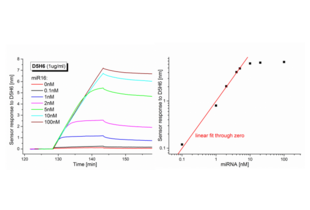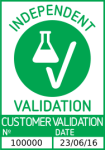RNA-DNA Hybrid antibody
-
- Target
- RNA-DNA Hybrid
- Reactivity
- All Species
- Host
- Mouse
- Clonality
- Monoclonal
- Application
- Chromatin Immunoprecipitation (ChIP), Immunofluorescence (IF), Immunohistochemistry (IHC), In situ hybridization (ISH)
- Specificity
- Reacts with RNA-DNA hybrid
- Purification
- Purified (protein A)
- Immunogen
- DNA-RNA duplex (random RNA-DNA heteropolymer)
- Clone
- D5H6
- Isotype
- IgG
-
- Application Notes
-
Working dilution: Optimal dilutions should be determined by the end user.
- Restrictions
- For Research Use only
-
- by
- Institute of Photonics and Electronics AS CR, v.v.i.
- No.
- #100000
- Date
- 06/23/2015
- Antigen
- RNA-DNA Hybrid
- Lot Number
- Method validated
- Surface Plasmon Resonance
- Positive Control
- RNA-DNA Hybrid complexes
- Negative Control
- ssDNA, dsDNA
- Notes
The ability of the D5H6 antibody to recognize and bind RNA/DNA hetero-duplexes was approximately twice lower than expected.
- Primary Antibody
- ABIN4889499
- Secondary Antibody
- Full Protocol
For the experiments a four-channel spectroscopic SPR sensor with a temperature controller developed at IPE was used. In general, the SPR assay was based on the attachment of biotinylated DNA probes to the SPR sensor surface via the streptavidin-biotin interaction, with the streptavidin covalently attached to the alkanthiol self-assembled monolayer, subsequent forming of RNA/DNA hybrid duplexes and monitoring of their interaction with RNA-DNA-hybrid antibody.
The respective steps of the assay were as follows:
- Streptavidin was covalently attached to the sensor surface via amine coupling according to the previously published protocol (Vaisocherová et al. (2006) Biopolymers 82:394-398).
- Biotinylated DNA probes were immobilized in 10mM Tris buffer. The amount of probes was calculated to be of 1012 probes/cm2 and was kept the same across all experiments.
- Complementary miRNA strands were bound in 10mM Tris + 15mM MgCl2 to form RNA-DNA hybrid duplexes. The concentration range of miRNA used was 0.1-100nM.
- The D5H6 at a concentration of 1µg/ml was used in all experiments.
All the experiments were performed at the temperature of 25°C and the flow rate of 20µl/ml.
- Experimental Notes
The sensor response to the binding of D5H6 antibody obtained for various concentrations of miRNA and corresponding calibration curve are shown at Fig.1. The calibration curve is plotted as a dependence of the sensor response to the binding of D5H6 antibody on the concentration of miRNA and is linear up to the miRNA concentration of 5nM.
As a negative control, the ssDNA (only biotinylated DNA probe) or dsDNA (homo-duplex with DNA analogue of the miRNA) surface was used. In both cases, the nonspecific sensor response to the binding of D5H6 was below 2% which falls into the inter-assay variability range.
Validation #100000 (Surface Plasmon Resonance)![Successfully validated 'Independent Validation' Badge]()
![Successfully validated 'Independent Validation' Badge]() Validation ImagesFull Methods
Validation ImagesFull Methods -
- Format
- Lyophilized
- Reconstitution
- Must be reconstituted in distilled water.
- Concentration
- 1 mg/mL
- Buffer
- Tris 0,1M, glycine 0,1M, sucrose 2 %
- Storage
- 4 °C/-20 °C
- Storage Comment
- Lyophilized powder stable for a minimum of 2 years at -20°C. Store reconstituted antibodies at +4°C. For extended periods store in aliquots at -20°C. Antibodies are guaranteed for 6 month from date of receipt.
- Expiry Date
- 24 months
-
- Target
- RNA-DNA Hybrid
- Target Type
- Nucleotide
-


 (1 validation)
(1 validation)



